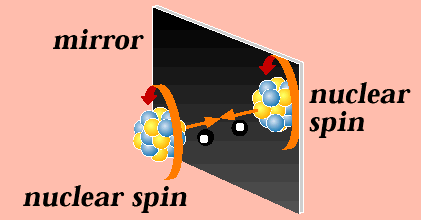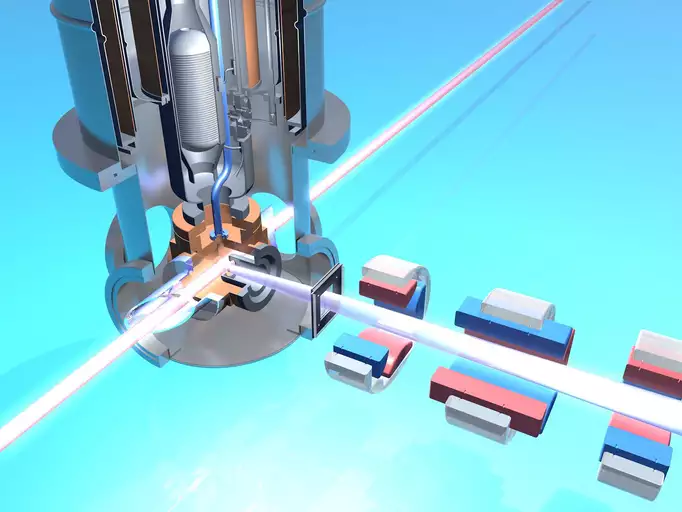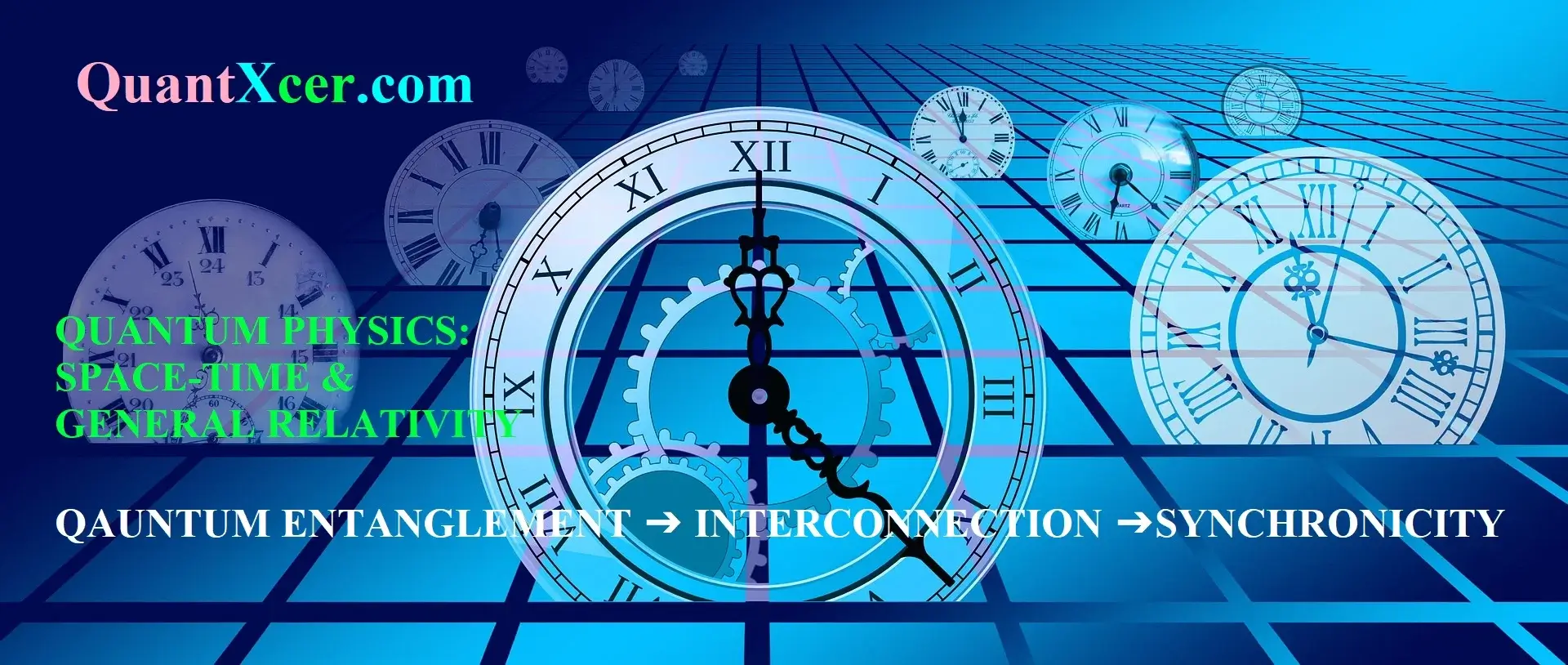Matter & AntiMatter Symmetry
According to the Standard Model of elementary particle physics, to each particle there exists an antiparticle that is supposed to behave exactly the same way. But this phenomena is difficult to prove, since it is almost impossible to perform measurements on antimatter: whenever an antiparticle meets is matter-counterpart, both particles annihilate, accompanied by the creation of energy. A recent research in Quantum Optics has found a way to overcome this hurdle: an experiment was carried out by trapping an antiproton inside a helium atom. As due to a new cooling technique the helium atoms are almost at rest, high precision spectroscopy measurements are made possible. For the mass of the antiproton relative to the electron, the outcome of the research has achieved the unprecedented accuracy of 800 parts per trillion.
In nuclear science the concept of symmetry plays a key role in gaining an understanding of the physical laws governing the behavior of matter. It provides a shortcut based on geometry for getting at some of Nature’s innermost secrets. Because the laws of physics are the same at any time (symmetry in time) and any location (symmetry in position) as another, the laws of conservation of energy and momentum apply.
Symmetry in Rotation
When an object is rotated through an angle of 360° it should end in a state no different from its initial state. If we apply this simple symmetry in quantum mechanics, the physics theory of matter and energy at the smallest distances, we find that it imposes the requirement that the angular momentum of rotating objects must be quantized in units of ℏ (Planck’s constant, h, divided by 2π). A spinning object, be it a planet, a top, or a nucleus, should only be able to have rotations such that its angular momentum comes out in "chunks" ℏ in size.this symmetry is considered to be "broken" by particles like electrons, protons and neutrons, which were found to have "spin 1/2", or one half an unit as their "built-in" angular momentum (called "intrinsic angular momentum" or simply "spin"). In nuclear science it has become standard to use as the measuring stick for angular momentum and to describe the angular momentum of nuclei in units of ℏ . Thus, we say that a nucleus has angular momentum 0, or 2, or 7/2, in units of ℏ .
One consequence of the half-integer spins of neutrons and protons is that nuclei with an odd number of nucleons must have half-integer angular momentum, while nuclei having an even number of nucleons must have integer angular momentum (in ℏ units). Another consequence is quite bizarre: objects with half-integer spin must be rotated by 720° (not 360°) before they return to their initial state! This peculiar behavior has been demonstrated using very slow (ultracold) spin-oriented neutrons from a reactor, which are split into two beams. In one beam the neutrons are rotated about an axis along their direction of motion through some angle, and then the beams are recombined. It is found that when the rotation angle is 360°, the combined beams are out of phase and cancel, (meaning that they are shifted away from the detector) while after 720° of rotation the beams are in phase and reinforced (meaning that they show a large signal at the detector). A rotation of 720° is needed to put the neutrons back in their original state.
Charge, Parity, and Time Reversal (CPT) Symmetry
Three other symmetry principles important in nuclear science are parity P, time reversal invariance T, and charge conjugation C. They deal with the questions, respectively, of whether a nucleus behaves in a different way if its spatial configuration is reversed (P), if the direction of time is made to run backwards instead of forward (T), or if the matter particles of the nucleus are changed to antimatter (C). All charged particles with spin 1/2 (electrons, quarks, etc.) have antimatter counterparts of opposite charge and of opposite parity. Particle and antiparticle, when they come together, can annihilate, disappearing and releasing their total mass energy in some other form, most often gamma rays.The changes in symmetry properties can be thought of as "mirrors" in which some property of the nucleus (space, time, or charge) is reflected or reversed. A real mirror reflection provides a concrete example of this because mirror reflection reverses the space direction perpendicular to the plane of the mirror. As a consequence, the mirror image of a right-handed glove is a left-handed glove. This is in effect a parity transformation (although a true P transformation should reverse all three spatial axes instead of only one).
Till several years ago, it was believed that the laws of physics were invariant under parity transformations and that no physics experiment could show a preference for left-handedness or right-handedness. Inversion, or mirror, symmetry was expected of nature. It came as some surprise that parity, P, symmetry is broken by the radioactive decay beta decay process. Scientists found that when a specific nucleus was placed in a magnetic field, electrons from the beta decay were preferentially emitted in the direction opposite that of the aligned angular momentum of the nucleus. When it is possible to distinguish these two cases in a mirror, parity is not conserved. As a result, the world we live in is distinguishable from its mirror image.

The image above illustrates this situation. The direction of the emitted electron (arrow) reverses on mirror reflection, but the direction of rotation (angular momentum) is not changed. Thus the nucleus before the mirror represents the actual directional preference, while its mirror reflection represents a directional preference not found in nature. A physics experiment can therefore distinguish between the object and its mirror image.
If, however, we made a nucleus out of antimatter (antiprotons and antineutrons) its beta decay would behave in the same way, except that the mirror image in Fig. 5-1 would represent the preferred direction of electron emission, while the antinucleus in front of the mirror would represent a directional preference not found in nature.
This point can be illustrated like : suppose you were in two-way contact with some alien species, but only by "telegraph" (i.e., light flashes or radio signals). The well known procedures of SETI (Search for Extraterrestrial Intelligence), starting with prime numbers and progressing to pictures, physics, and chemistry information could be used to develop a common language and arrive at a good level of communication. You could tell the alien how tall you are by expressing your height in mutually understood wavelengths of light. You could tell the alien how old you are as some large number of ticks of a light-frequency clock. Now you want to explain how humans shake hands when they meet, and you describe extending your right hand. What is meant by ‘right’?
Till several decades ago, there would have been no way of answering that question. But now you could use the parity experiment shown in Fig. 5-1. You could tell the alien to turn the experiment until the electrons come out in the upward direction (the direction opposite gravity), and the front edge of the rotating nucleus will move from right to left or clockwise to make the angular momentum. This works because the parity violation of the weak interaction allows us, at a fundamental level, to distinguish right from left.
Another punch line to this illustration is : Suppose, after lots of communication you finally can go into space and meet your alien counterpart. If, as you approach one another, the alien extends its left hand to shake, watch out! He’s made of antimatter! This, of course, is because a parity violation experiment constructed of antimatter would give the opposite result.
If the mirror in the image above not only reversed spatial direction but also changed matter to antimatter, then the experiment in front of the mirror would look just like its mirror image. Changing both C and P preserves the symmetry and we call this CP symmetry. The separate violations of P symmetry and C symmetry cancel to preserve CP symmetry. These symmetry violations arise only from the weak interaction, not from the strong and electromagnetic interactions, and therefore shows up strongly only in beta decay.
There are fundamental reasons for expecting that nature at a minimum has CPT symmetry–that no asymmetries will be found after reversing charge, space, and time. Therefore, CP symmetry implies T symmetry (or time-reversal invariance). One can demonstrate this symmetry by asking the following question. Suppose you had a movie of some physical process. If the movie were run backwards through the projector, could you tell from the images on the screen that the movie was running backwards? Clearly in everyday life there would be no problem in telling the difference. A movie of a street scene, an egg hitting the floor, or a dive into a swimming pool has an obvious "time arrow" pointing from the past to the future. But at the atomic level there are no obvious clues to time direction. An electron orbiting an atom or even making a quantum jump to produce a photon looks like a valid physical process in either time direction. The everyday "arrow of time" does not seem to have a counterpart in the microscopic world–a problem for which physics currently has no answer.
Till severla decades ago, it was thought that the combination CP was a valid symmetry of the Universe. That year, Christenson, Cronin, Fitch and Turlay observed the decay of the long-lived neutral K meson, p + + p -. If CP were a good symmetry, the would have CP = -1 and could only decay to three pions, not two. Since the experiment observed the two pion decay, they showed that the symmetry CP could be violated. If CPT symmetry is to be preserved, the CP violation must be compensated by a violation of time reversal invariance. Indeed later experiments with K0 systems showed direct T violations, in the sense that certain reaction processes involving K mesons have a different probability in the forward time direction (A + B Æ C + D) from that in the reverse time direction (C + D Æ A + B). Nuclear physicists have conducted many investigations searching for similar T violations in nuclear decays and reactions, but at this time none have been found.
This may change soon. Time reversal invariance implies that the neutron can have no electric dipole moment, a property implying separation of internal charges and an external electric field with its lines in loops like Earth’s magnetic field. Currently ultracold neutrons are being used to make very sensitive tests of the neutron’s electric dipole moment, and it is anticipated that a nonzero value may be found within the next few years.
Matter and Antimatter
Time-reversal invariance and the CP violation are connected to another asymmetry of the universe, the imbalance between matter and antimatter. At the microscopic level, matter and antimatter are always created together in 1:1 correspondence. High energy collisions produce equal numbers of quarks and antiquarks. And yet, our universe has a conspicuous surplus of matter, of which we and our surroundings are made. How did this happen?A clue to this deep mystery is provided by the CP violation in the Ko meson, which shows decay modes having a preference for matter over antimatter. The Ko does not have enough mass for its decay to produce protons, but its decay asymmetry suggests that some more massive particle, perhaps a Bo meson containing a bottom quark, might in the early universe have decayed preferentially into protons rather than antiprotons, leading to the present day dominance of matter. Future experiments using the B-Factory in the Stanford Linear Accelerator Center (SLAC) will investigate this problem.
Antimatter exists in nature only in the form of antiprotons present in very small numbers in cosmic rays and in positrons (antimatter electrons) produced in some radioactive decays. Recently, evidence has also been found for a "fountain" of positrons ejected from some object near the center of our galaxy, presumably a black hole.
However, we are getting better and better at producing and storing antimatter in the laboratory. Antiprotons, antineutrons, and even antideuterons (a nucleus consisting of an antineutron and an antiproton) are routinely produced using high energy particle accelerators. Positrons and antiprotons have been trapped in electric and magnetic fields and held under high vacuum for several months. Recently, "antihydrogen" atoms having a positron orbiting an antiproton have been formed in laboratory experiments. These researchers are looking for any indication that trapped positrons, antiprotons, and antihydrogen atoms show a behavior that differs in any way from that of their normal matter counterparts, because any such difference would represent a violation of CPT symmetry.
Antimatter nuclei are also interesting for other reasons. Special facilities at CERN and Fermilab provide beams of low energy antiprotons and permit nuclear scientists to study the interactions of antiprotons with matter. While a positron and an electron usually annihilate to form a pair of gamma-ray photons traveling in opposite directions, the annihilation of an antiproton with a proton is more complicated. Several p mesons are usually produced. About a third of the mass energy of the proton-antiproton pair becomes inaccessible in the form of energetic neutrinos.
Nevertheless, antimatter can be viewed as an extremely compact form of stored energy that can be released at will by annihilation with matter. Design studies of antimatter-powered space vehicles which when given a supply of antimatter look quite feasible. The problem with such schemes is that production of any significant quantity of antimatter would cost far too much right now to be economically feasible.
Other Symmetries
In addition to the symmetries described above, nuclear scientists use a number of other approximate symmetries to describe and predict the behavior of nuclei. Examples of these are charge independence, the expectation that, at the nuclear level, neutron-proton systems should behave the same as proton-proton or neutron-neutron systems; and charge symmetry, the expectation that the interactions between two neutrons should be the same as that between two protons. Charge symmetry can be demonstrated by comparing "mirror nuclei," two low-mass nuclei that have their neutron and proton numbers interchanged and which have very similar nuclear structure, for example 13C (Z=6, N=7) and 13N (Z=7, N=6).A related symmetry is isospin symmetry, which is related to interchanging the roles of neutrons and protons in certain nuclei. These three symmetries are destroyed when the Coulomb force becomes sufficiently strong, but nevertheless they have proved to be useful approximations in many areas of nuclear science.
Confirmation Of Matter-antimatter Symmetry With record precision
The Antiproton Decelerator (AD) was constructed to perform experiments on the antimatter particles. Here antiprotons produced in high-energy collisions are collected and stored in a vacuum pipe arranged in a 190-m-long racetrack shape. The antiprotons are gradually slowed down, before being transported to several experiments. The so-called ASACUSA (Atomic Spectroscopy and Collisions using Slow Antiprotons) sends the antiprotons into a helium gas target. Normal helium atoms consist of a nucleus with two electrons orbiting around it. When the antiprotons hit the helium atoms, about 3% of the antiparticles replace one of the electrons, resulting in antiprotonic helium. The antiproton finds itself in an excited orbit some 100 picometres (10-10 m) from the nucleus. In order to determine its mass the scientists perform precision spectroscopy: they fire a laser beam onto the atom, and carefully tune its frequency until the antiproton makes a quantum jump from one energy orbit to another. By comparing this frequency with theoretical calculations, the mass of the antiproton can be determined relative to the electron.
Image source: Max Planck Institute of Quantum Optics, Research Group - Antimatter Spectroscopy
However, an important source of imprecision remained so far, because the antiprotonic atoms move around randomly according to their thermal energy, so that atoms moving towards the laser beam experience a different frequency compared to those moving away. The new major achievement of the collaboration as reported in Science, lies in the fact that ASACUSA now managed to cool down the antiprotonic helium atoms to temperatures close to absolute zero - between 1.5 and 1.7 Kelvin. the atoms were cooled down using buffer-gas cooling. It is a surprising fact that this method works at all, because normally – if the normal matter atoms are used to cool a half-antimatter atom – it is expected that the atom would annihilate instead of cooling down. But here annihilation is prevented because the antiproton is safely shielded by the electron. The new measurements, based on data collected from over several years, with about 2 billion atoms, showed that the antiproton is 1836.1526734(15) times heavier than the electron, the parenthesis showing the 1-standard deviation imprecision. This is in excellent agreement with a recent experimental value for the proton-to-electron mass ratio.
Physicists believe that the laws of nature obey a fundamental symmetry called “CPT” (this stands for charge conjugation, parity, and time reversal), which postulates that if all the matter in the universe were replaced with antimatter, left and right inverted as if looking into a mirror, and the flow of time reversed, this “anti-world” would be indistinguishable from our real matter world. If scientists were to experimentally detect any deviation, however small, it would indicate that this fundamental symmetry is broken. And this could possibly lead to an explanation of why the universe we live in is made entirely of matter, whereas at the beginning of the universe, in the “big bang”, matter and antimatter was created in the same amount. It is possible to even improve this precision by combining buffer-gas cooling with two-photon spectroscopy, a method that by itself reduces uncertainties caused by the Doppler-effect. Scientists are planning a new experiment to this end.
